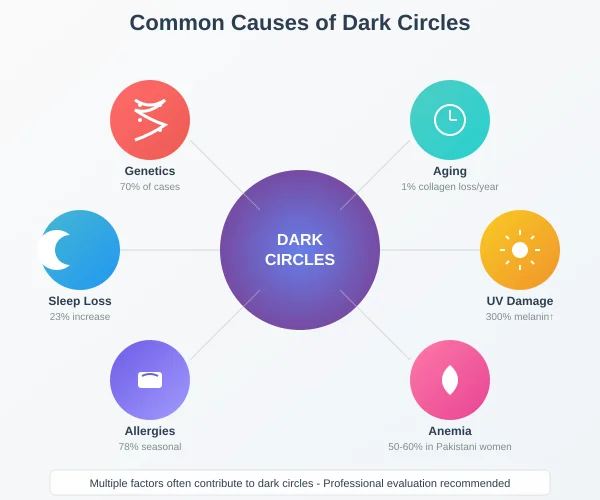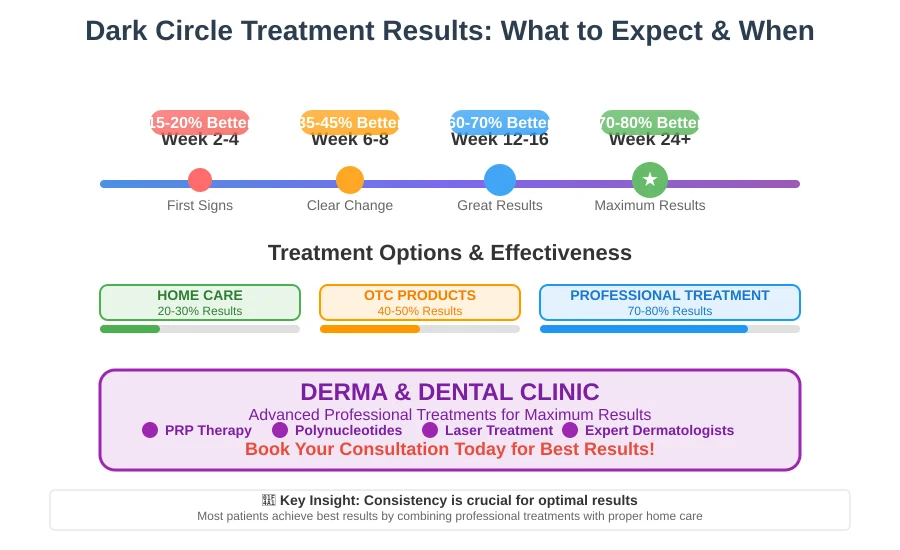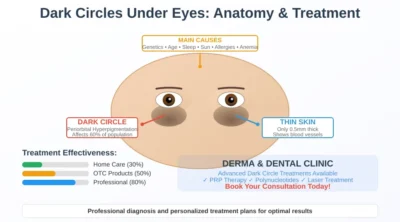Dark Circles Under Eyes: Causes and Treatment Options That Actually Work
Dark circles under the eyes are one of the most common cosmetic concerns affecting people of all ages in Pakistan. Whether you’re dealing with hereditary dark circles, lifestyle-related puffiness, or age-related changes, understanding the root causes and effective treatments can help you achieve brighter, more youthful-looking eyes.
What Are Dark Circles Under Eyes?
Dark circles, medically known as periorbital hyperpigmentation, appear as darkened areas of skin beneath the lower eyelids. According to a study published in the Journal of Cosmetic Dermatology, periorbital hyperpigmentation affects up to 60% of the population, with higher prevalence in individuals with darker skin types common in South Asian populations.
The delicate skin around the eyes is significantly thinner than other facial areas—measuring only 0.5mm compared to 2mm on the rest of the face, as documented in dermatological research. This thinness, combined with various internal and external factors, creates the appearance of dark, tired-looking eyes.
Common Causes of Dark Circles

Genetic Factors:
Heredity plays a significant role in dark circle formation, with studies showing that genetic predisposition accounts for up to 70% of cases. Research published in the International Journal of Dermatology demonstrates that if both parents had prominent dark circles, offspring have an 85% likelihood of developing them. Genetic factors influence skin thickness, melanin production, and the structure of blood vessels around the eyes.
Age-Related Changes:
As we age, the skin around our eyes becomes thinner and loses collagen and elastin. Research from the American Academy of Dermatology shows that collagen production decreases by approximately 1% per year after age 25. This natural aging process makes blood vessels more visible and creates a hollow appearance that emphasizes dark circles. A clinical study in Dermatologic Surgery found that facial fat redistribution begins as early as the mid-20s, with fat pads under the eyes shifting or diminishing, creating shadows that appear as darkness.
Lifestyle Factors:
Sleep Deprivation: Lack of adequate sleep causes blood vessels to dilate, making dark circles more prominent. Poor sleep quality also leads to fluid retention, creating puffiness that casts shadows under the eyes.
Dehydration: Insufficient water intake causes the delicate under-eye skin to appear dull and sunken, emphasizing the contrast with surrounding areas.
Screen Time: Extended exposure to digital screens strains the eyes and can worsen the appearance of dark circles, especially common in Pakistan’s growing tech-savvy population.
Environmental Factors in Pakistan:
Sun Exposure: Pakistan’s intense sunlight increases melanin production around the eyes, leading to hyperpigmentation. The UV rays break down collagen, making the skin thinner and more susceptible to dark circles.
Air Pollution: Urban areas like Karachi, Lahore, and Islamabad have high pollution levels that can irritate the delicate eye area, causing inflammation and darkening.
Medical Conditions:
Allergies: Seasonal allergies common in Pakistan, particularly during spring and autumn, cause itching and rubbing that darkens the under-eye area.
Anemia: Iron deficiency, prevalent in many Pakistani women, reduces oxygen delivery to tissues, making dark circles more apparent.
Thyroid Disorders: Both hyperthyroidism and hypothyroidism can affect circulation and cause fluid retention around the eyes.
Types of Dark Circles
Pigmented Dark Circles:
These appear brown or black and are caused by excess melanin production. They’re more common in individuals with darker skin tones, including many people of South Asian descent.
Vascular Dark Circles:
These appear blue or purple and result from dilated blood vessels showing through thin skin. They’re often more noticeable in fair-skinned individuals.
Structural Dark Circles:
These are caused by the natural eye socket structure creating shadows. They become more prominent with age as facial fat redistributes.
Home Remedies and Lifestyle Changes
Sleep Optimization:
Aim for 7-9 hours of quality sleep nightly. Elevate your head slightly while sleeping to prevent fluid accumulation under the eyes. Establish a consistent sleep schedule, which is particularly important given Pakistan’s varying prayer times and social schedules.
Hydration and Nutrition:
Drink at least 8-10 glasses of water daily, especially important in Pakistan’s hot climate. Include iron-rich foods like spinach, lentils, and dates in your diet to combat anemia-related dark circles.
Cold Compresses:
Apply cold cucumber slices, chilled tea bags (particularly green or chamomile tea), or cold spoons to the under-eye area for 10-15 minutes daily. The cold temperature constricts blood vessels, reducing the appearance of vascular dark circles.
Sun Protection:
Use broad-spectrum sunscreen with SPF 30 or higher around the eyes daily. Wear sunglasses and wide-brimmed hats when outdoors, essential protection against Pakistan’s strong UV rays.
Over-the-Counter Treatment Options
Eye Creams with Active Ingredients:
Vitamin C: Look for stable forms like magnesium ascorbyl phosphate or sodium ascorbyl phosphate. Vitamin C brightens pigmentation and stimulates collagen production.
Retinol: Start with low concentrations (0.25-0.5%) to avoid irritation. Retinol increases cell turnover and thickens the delicate under-eye skin.
Caffeine: Helps constrict blood vessels and reduce puffiness. Many affordable eye creams available in Pakistani pharmacies contain caffeine.
Niacinamide: Reduces inflammation and helps lighten pigmentation. This ingredient is well-tolerated by most skin types.
Natural Ingredients Popular in Pakistan:
Almond Oil: Rich in vitamin E, helps nourish and moisturize the under-eye area. Apply gently before bedtime.
Rose Water: Has anti-inflammatory properties and can be applied with cotton pads as a soothing treatment.
Turmeric Paste: Mix turmeric with milk or yogurt for a traditional remedy, but use sparingly to avoid staining.
Professional Treatment Options
Dermatologist-Recommended Treatments:
Topical Prescription Creams: Tretinoin, or combination creams can effectively lighten pigmented dark circles when used under professional supervision.
Laser Therapy: Q-switched lasers or IPL treatments target pigmentation and stimulate collagen production. These treatments are increasingly available in major Pakistani cities.
Platelet-Rich Plasma (PRP): PRP your own blood platelets to stimulate collagen production and improve skin texture around the eyes.
Dermal Fillers: Hyaluronic acid fillers can address structural dark circles by restoring volume to the under-eye area.
Microneedling: Stimulates collagen production and improves product penetration for better treatment results.
Polynucleotide Therapy: An advanced regenerative treatment that uses purified DNA fragments to enhance skin repair mechanisms. Research published in Aesthetic Plastic Surgery demonstrates that polynucleotide injections improve periorbital skin quality by promoting fibroblast activity and increasing hyaluronic acid production naturally. This treatment is particularly beneficial for patients with age-related dark circles and thin under-eye skin.
At Derma & Dental Clinic, we offer all these advanced treatments with state-of-the-art equipment and expert dermatologists. Book an appointment to discuss which treatment option is best for your specific type of dark circles.
When to See a Dermatologist:
Consult a qualified dermatologist if:
- Dark circles persist despite consistent home treatment
- They appear suddenly or worsen rapidly
- You experience additional symptoms like swelling, pain, or vision changes
- You suspect underlying medical conditions
- You’re considering professional treatments
Ready to get professional help? Visit Derma & Dental Clinic for expert evaluation and personalized treatment plans. Our experienced dermatologists specialize in treating dark circles and other skin concerns with the latest technology and proven methods.
Prevention Strategies:
Daily Skincare Routine:
Morning: Gentle cleanser, vitamin C serum, moisturizer, and broad-spectrum sunscreen Evening: Gentle makeup removal, cleanser, retinol or niacinamide serum, and nourishing eye cream
Lifestyle Modifications:
- Manage stress through meditation or prayer, important aspects of Pakistani culture
- Limit sodium intake to reduce fluid retention
- Use a humidifier during dry seasons
- Take regular breaks from screen time
- Address underlying allergies with appropriate treatment
Realistic Expectations and Timeline:
Dark circle improvement requires patience and consistency. Most people see initial results within 4-6 weeks of starting treatment, with significant improvement after 3-6 months. Genetic and structural dark circles may require ongoing maintenance rather than complete elimination.

Conclusion:
Dark circles under the eyes are a common but treatable concern. By understanding the underlying causes and implementing appropriate treatments, you can achieve noticeable improvement. Whether you choose home remedies, over-the-counter products, or professional treatments, consistency is key to success.
For persistent or severe dark circles, consulting with our qualified dermatologists at Derma & Dental Clinic ensures you receive appropriate treatment tailored to your specific condition and skin type. Book your consultation today to get a personalized treatment plan that addresses your unique concerns.
Remember that the delicate eye area requires gentle care and patience for optimal results. With the right approach and professional guidance, you can significantly reduce the appearance of dark circles and achieve brighter, more refreshed-looking eyes that boost your confidence and overall appearance.
Contact Derma & Dental Clinic today to schedule your appointment and take the first step toward brighter, healthier-looking eyes.

